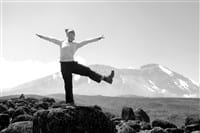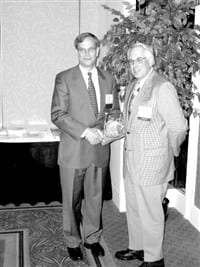At The Top Of Her Game Local Climber Scales Mount Kilimanjaro To Raise Funds, Awareness Of Breast Cancer
Laurie Normandeau remembers the final push to the top of Mount Kilimanjaro.
It started at midnight, a time chosen to ensure that climbers could scale the final 4,000 feet to the summit, Uhuru Peak, and then safely return to the 10,000-foot level before dark. “It was pitch black,” she recalls. “The only thing you could see was the little bit of ground in front — you were essentially following the feet of the person directly in front of you. There were other teams making their way to the top, and all you could see were lines of lights off in the distance. It was an awesome sight.”
There were many such sights in Normandeau’s two-week-long odyssey, a climb of Africa’s tallest mountain (19,340 feet), staged to raise money to fight breast cancer. A local rock climbing instructor, Normandeau was one of 16 individuals who raised $10,000 for the Fred Hutchinson Cancer Research Center in Seattle, and thus earned the right to take on Kilimanjaro.
In an interview with The Healthcare News soon after returning to her home in Northampton, Normandeau said the climb tested her in ways she couldn’t have imagined.
“There were a few times when all of us had doubts about whether we were going to make it,” she recalled, adding that she had such thoughts in the hours before the final ascent when she was battling a fever and other cold symptoms. “But I had come so far, I wasn’t going to stop.
“I pulled it together and got caught up in the moment,” she continued. “The whole time we were there people supported one another. We used that energy to take us to the top.”
The Healthcare News looks back this month on Normandeau’s epic climb, which she described as a stern test of mind and body — and one with a purpose that went well beyond personal achievement.
Boulder Colors
It’s called volcanic scree.
That’s the dark, powdery material that covers much of Mount Kilimanjaro, an extinct volcano, and it was a source of many challenges for the climbers. The scree is slippery, said Normandeau, meaning that it’s hard to gain traction when moving up, and especially when heading down, an exercise she said resembled skiing or sliding. Meanwhile, with each step on the scree, climbers kick up fine powder, which gets in the lungs, she explained as she experienced a coughing fit that reminded her that she was still living with what’s called “Kilimanjaro Black Lung.”
There were many other obstacles to overcome on the climb, said Normandeau, especially altitude, which the climbers tried to prepare for, but couldn’t, in reality. There was also cold (which froze everything from water to cameras), fatigue, and intermittent doubt about whether they could make it to the top. To clear those hurdles, climbers used a combination of preparation and persistence.
That preparation began soon after Normandeau learned about the Climb to Fight Breast Cancer, which was initiated several years ago and has involved climbs on several continents. She said the program provided an opportunity to blend her passion for rock climbing with a desire to battle cancer, which claimed her mother several years ago.
To participate in the program, individuals must be avid climbers, naturally, but they must also make a commitment to raising not only $10,000 for the Hutchinson Cancer, but also the $5,000 in expenses that would be incurred while getting to Tanzania and back.
While preparing physically for the climb, Normandeau also set about raising money, and she went about both tasks with equal passion. In fact, she wound up as the top fundraiser in her group, with more than $16,000. When asked for the specific total, she said. “I don’t know, I just got another check yesterday … as people find out about this, they continue to send in money.”
Normandeau said her climb attracted some area press accounts, including a piece in The Healthcare News, which helped bring attention to the program. She said contributions came from a number of area businesses, as well as individuals who have been impacted by breast cancer in some way.
To prepare physically for Kilimanjaro, Normandeau crafted a regimen that included a study diet of climbing and strength and cardiovascular work. By last May, she was climbing the 3,165 feet of New Hampshire’s Mount Monadnock every other day. As the climb drew closer, she focused on light, flat hiking — as well as some yoga — in an effort to keep her legs strong but not burn out.
Getting a Leg Up
For the first few days of the climb, Normandeau said she felt well-conditioned. The pace of the ascent was slow, in an effort to help climbers get over jet lag and become adjusted to altitude changes.
As they moved higher up the mountain, however, the effects of elevation started taking their toll physically and mentally in the form of uncertainty about what to expect and how one’s body would react.
“I wouldn’t call it nervousness,” she said, “but I had thoughts every day like, ‘what am I going to feel like at this altitude?’ or ‘is this the day I’m really going to start feeling it?’
“Eventually, no one really cared what time it was,” she continued. “People were more concerned with altitude checks and how their body would react at certain heights. It’s hard to know what to expect … altitude’s effects vary from person to person; I wanted to be as well-prepared physically as I could, and hope that would get me through whatever I encountered.”
Normandeau said that one of the most exciting, but in some ways frustrating parts of the climb was the scaling of the Great Barranco, a very steep section near the 14,000-foot mark that was encountered on the fifth day.
“Of all the hiking we had to do, this was the most technical,” she explained, adding that it was also very similar to her specialty, rock climbing. “I thought I was really in my element, but in my zeal, I misjudged on expending energy — I really needed to cover up more.
“By the end of that day, I could tell I was overexposed to the sun, and I was really upset with myself,” she continued. “Any little mistake like that can be magnified at that altitude.”
But while Normandeau’s miscalculation left her somewhat drained, it didn’t keep her from reaching the summit. And the final push provided some of the most enduring memories of the trip.
She especially remembers the views as the sun began to rise. “We were way above the clouds,” she recalled. “When you’re looking down on clouds like that it looks like an ocean.”
Individuals made their way to the summit over a nine-hour stretch, she said, with the conditions taking varying tolls on the climbers. Up until the final push to the summit, the climbing had been as a group. That morning, however, the unity was broken by the thin air, cold, and fatigue.
“Some people were sick, some fatigued, needing longer breaks, which broke us into smaller groups,” she explained. “The altitude and thin air took their toll in different forms. For some it was labored breathing, dizziness, nausea, and a sensation of being drunk.
“The extreme cold was another factor adding to the challenge,” she continued. “Taking any breaks meant colder fingers and toes; it also made eating and staying hydrated impossible, which led to further fatigue and headaches. Some of us were disoriented, losing track of the rest of the team’s whereabouts.”
The climbers didn’t have much time on the summit to reflect on their triumph before heading back down, but Normandeau did take a minute to savor the accomplishment — and to think about the cancer victims and survivors who inspired her.
“I didn’t do this just to scale the highest mountain in Africa,” she explained. “I did it to raise awareness of breast cancer and get people to join the fight. So we had success on a number of levels.”
Summit Meeting
As she looked back on her climb, Normandeau said it was an incredible experience, one she imagines must be similar in some ways to surviving cancer.
“It’s an amazing feeling when you do something that you’re not sure you’re going to be able to do,” she said. “This was a challenge I’ll never forget.”



Comments are closed.